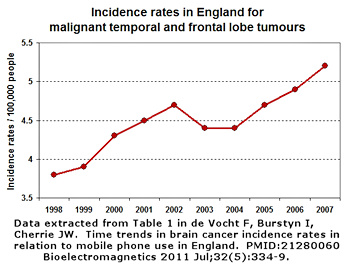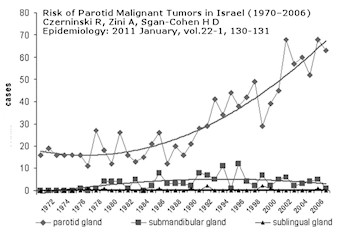27/05/2011 - Clear evidence that cell phone use increases the incidence of head cancers
We believe that urgent action is needed to protect our children and young people from a epidemic of brain and other tumours in 10 to 30 years time. The majority of malignant gliomas (the most common type that has been associated with mobile phone use) are fatal within 3 to 5 years of diagnosis, even with treatment. If a large rise in numbers occurs then there is no way that we will have enough neurosurgeons or public money to treat them.
In our view it is now morally irresponsible to allow children and young people under 16 to have and regularly use mobile phones held to their head or carried on their body. Even the UK Department of Health has been saying since 2000 that "children and young people under 16 should be encouraged to use mobile phones for essential purposes only, and to keep calls short."
Yet parents and grandparents are not only buying pay-as-you-go handsets but mostly signing long-term mobile phone contracts for their children and grandchildren.
Further damning evidence is emerging this week from the announcement of more of the long overdue results from the large multi-country Interphone study that completed data collection back in 2004.
We now learn that a forthcoming paper based on Interphone data for tumours located closest to where you hold your phone to your head (i.e. mainly gliomas in the temporal and frontal lobes) will report a significantly increased risk after only 7 years of using a mobile phone and that this risk increases over time. It is not restricted to the highest users — some occasional users seem particularly susceptible.
We also understand that many European countries, including the UK, which took part in the Interphone study refused
to have their data used in this brain-region analysis. This seems extraordinary behavior by public health scientists. What
is going on — who is pulling the strings?
No overall rise in malignant brain tumours is yet showing in most national cancer statistics, though de Vocht has recently reported what we interpret as a worrying recent rise in UK Office for National Statistics cancer registry data for England [6]. The change in incidence of temporal and frontal lobe tumours (close to where most radiation enters the user's head) is shown in the graph on the right that we have derived from their published data. The slight fall in 2003-2004 can be also seen across various non-brain cancers in ONS data and is likely to be a cancer registry recording artefact. Maybe this graph explains the UK Interphone researchers refusal to allow their data to be used in the new Interphone brain-region analysis.
Another forthcoming Interphone paper confirms an increase in acoustic neuromas, a less dangerous cancer of the acoustic nerve, on the side of the head where the mobile is most frequently used.
Microwave News is keeping the world up to date on these developments
— read the main news and the Short Takes here: "Latest Microwave News".
Three meta-analyses of case-control studies have concluded that that using a cell phone for more than 10 years was associated with an increase in the overall risk of developing a brain tumour.[Refs 1,2,3] All three found statistically significant more brain tumours in people who had used a cell phone for more than ten years and one study reported a doubling of glioma on the same ("ipsilateral") side the cell phone was used (118 cases, OR=1.9; 95% CI, 1.4-2.4).
Although the Interphone initially reported an overall reduction in risk associated with mobile phone use, more refined analysis by the authors later showed a doubling in glioma incidence for over ten years regular mobile phone use (190 cases, glioma OR=2.18, 95% CI, 1.43-3.31) with a similar result for cumulative hours call time. [Refs. 4,5]
Earlier this year Rakefet Czerninski and colleagues published a paper looking at
parotid gland cancers in Israel over the period 1970 to 2006 [7]. Whilst other salivary gland tumours remained stable at low levels, the incidence of parotid gland tumours (in the side of the head close to where a mobile phone is held) rose four-fold. This is shown in the graph on the left. There may be another explanation though no-one seems to offer a reasonable one. If it were better diagnosis, the other salivary gland tumours would also be on the increase.
There are plenty of good, peer-reviewed, scientific reports in the literature showing evidence of biological effects that are likely to lead to adverse effects on health and well-being.
We have prepared a list of 150 selected studies as a XLS spreadsheet, also as a web page, with main authors, title, journal and PubMed hyperlinks so that you can easily go and see the details. These are all concerned with exposure to mobile phone signals at specific absorption rates (SARs) below the 2 W/kg level that is set as the maximum allowed from a mobile phone handset in Europe. Yet in 2009 the EC's SCENIHR working group still concluded that there was no need for any precautionary action such as specific advice for children's use of mobile phones, though they did call for more research.
The WHO's International Agency for Research on Cancer (IARC) is meeting in Lyon this week (24-31 May 2011) to decided what, if any, classification to give RF/microwave exposure. On Tuesday the Director of IARC, Dr Christopher Wild, gave an excellent welcome speech to members. Let us hope that the meeting deliberations and outcome will live up to these stated ideals.
Recent revelations
In the last week, two people closely connected with the EMF-health debate have been shown to have industry associations that they have not declared as possible "conflicts of interest" as they are required to do. Dr Rene de Seze of INERIS, the French National Institute for Environment and Industrial Risk, was featured in a long documentary on French television last week and shown to be "less than honest" with his statements and mobile phone safety issues. He has given key advice to the EC SCENIHR committee.
Much more concerning were revelations about Professor Anders Ahlbom. He has been one of the leading academics on EMF (ELF and RF) and health in Europe for the last 20 years. He has been on almost all the key committees on these issues and has Chaired many of them. Apart from Mike Repacholi (ex WHO EMF Project Head) no-one else has been so influential. It turns out that his brother has worked for the mobile telecommunications industry at a very high level for the past 20 years. He and Anders set up a new Lobbying business based in Brussels two years ago. Back in the 1990's Anders Ahlbom was supporting the association between power-frequency EMFs and childhood leukaemia - indeed he is the lead author on one of the key meta-analysis papers. However in the last few years he has become outspokenly dismissive of any suggested links between electromagnetic fields and adverse health effects. Last year he declared that "mobile phones are safe".
After the revelations, he was stopped from being a member of this week's IARC meeting and from Chairing the epidemiology committee. In response he tried making accusations against Professor Lennart Hardell, a leading neurosurgeon in Sweden who has published many papers showing the rise of brain cancer with mobile and cordless phone use. Ahlbom has long tried to stop Lennart from publishing epidemiology. Ahlbom's accusations did not stand up to testing and Hardell stays a member of the IARC panel.
Lisez cet article en francais: Teslabel version
References
- Myung SK, Ju W, McDonnell DD, et al. Mobile phone use and risk of tumors: a meta-analysis. J Clin Oncol. 2009 Nov 20; 27(33):5565-72. [see on PubMed]
- Khurana VG, Teo C, Kundi M, Hardell L, Carlberg M. Cell phones and brain tumors: a review including the long-term epidemiologic data. Surg Neurol. 2009 Sep;72(3):205-14; discussion 214-5. Epub Mar 2009. [see on PubMed]
- Kan P, Simonsen SE, Lyon JL, Kestle JR. Cellular phone use and brain tumor: a meta-analysis. J Neurooncol. 2008 Jan;86(1):71-8. Epub 2007 Jul 10. [see on PubMed]
- Interphone group. Brain tumour risk in relation to mobile telephone use: results of the INTERPHONE international case-control study. Int J Epidemiol. 2010 Jun;39(3):675-94. Epub 2010 May 17 [see on PubMed]
- Interphone Sudy Group. Appendix 2 of Brain tumour risk in relation to mobile telephone use: results of the INTERPHONE international case-control study. Int J Epidemiol. 2010 Jun;39(3):675-94. Epub May 2010. [see in Journal]
- de Vocht F, Burstyn I, Cherrie JW. Time trends (1998-2007) in brain cancer incidence rates in relation to mobile phone use in England. Bioelectromagnetics. 2011 Jan 28. doi: 10.1002/bem.20648. [see on PubMed]
- Czerninski R, Zini A, Sgan-Cohen HD, Risk of Parotid Malignant Tumors in Israel (1970-2006). Epidemiology: January 2011, Vol.22-1, 130-131. [see in Journal]
Further commentary
Who is controlling the assessment of the science for public safety?
There are many groups with an interest in this debate, including us, each with their own agendas. In a  paper (190 KB pdf) that we presented at a 2002 conference at the Royal College of Physicians in London on EMF and Health in Buildings Conference Proceedings book we highlighted the following: paper (190 KB pdf) that we presented at a 2002 conference at the Royal College of Physicians in London on EMF and Health in Buildings Conference Proceedings book we highlighted the following:
- The public want the benefits of the latest technologies, but want and expect them to be risk-free. Unfortunately, life is a risky process. The only thing we can be sure about is that we will eventually die. Before that happens, most of us wish for a long and healthy life. People expect things on the open market to be safe or to carry clear safety warnings.
- The Government wants a quiet life, a thriving economy, cheapness and popularity. National governments now receive enormous sums in various taxes (etc) arising from mobile phone use. In the UK the total is now running about £ 20 bn per year - an enormous sum of money - more than the tax revenue from alcohol and tobacco combined. The Treasury does not want this income stream disrupted.
- Business wants a thriving economy with maximal profits and no onerous duties or liabilities. The wireless industry is such a large growth business with enormous infrastructure investments that, of course, it wants no problems and spends a lot of money lobbying policy makers each year to ensure its voice is heard (including hosting parties and fringe meetings at the political party conferences). They employ teams of professional lobbyists in each country and in Brussels to lobby the European Parliament and Commission. There is nothing illegal about that - they are just looking after their financial interests - but they do have a very large influence.
The dangers of cigarette smoking and asbestos exposure were long denied, with government support.
When tetra-ethyl lead (an anti-knock agent and also a recognised brain poison) was removed from petrol by law in the 1990s, the petrochemical industry lobbied hard to replace it with benzene as "by far the cheapest and best option". It just so happens that benzene is a toxic waste product from petrochemical refining and the industry was paying to dispose of large quantities of it. It is one of the few known causes of myeloid leukaemia. A brain poison was removed and replaced with a known carcinogen purely due to industry lobby pressure. After a few years this was changed and petrol now contains low levels of benzene.
- Scientists want interesting problems and continued research funding. A significant part of the problem is to do with scientists and their relationship with politicians and with society (and vice-versa). There are many factors here.
There are still some scientists (including some eminent ones) with an old-fashioned mechanical view of universe and the way the environment affects living beings and insist on the basic mechanical laws of physics as they understand them. This results in a view of RF/microwave interactions that is expressed as "if it doesn't heat you, it won't harm you". Modern science has shown that this is an inappropriate model for long-term interactions with living beings (especially humans with their long life-span and very different sensitivities) that I will explore shortly in another Powerwatch article. It really is last-century's science.
There are many scientists who "just want to do the science" and leave the societal implications for others to judge. This is the way many scientific committees work. About 15 years ago I had an exchange of letters with Sir Richard Doll. I was complaining that the UK NRPB Advisory Group on Non-Ionising Radiation (AGNIR) never translated their judgments into a form suitable for public advice. He wrote that he believed it was important to keep the processes quite separate and it was up to others to formulate public guidance and regulations. There is large problem here as there are very few scientists and engineers in Parliament - which is governed largely by financial and short-term economic considerations - leaving important decisions very vulnerable to outside influences and misdirection.
The UK Department of Health recently confirmed: "As a precaution, the UK Chief Medical Officers advise that children and young people under 16 should be encouraged to use mobile phones for essential purposes only, and to keep calls short. If you are concerned, you can take steps to reduce your exposure such as using hands free kits or texting." Past Government Chief Scientist (1992-95), Sir William Stewart who later Chaired the Independent Expert Group on Mobile Phones (IEGMP) and then the Mobile Telephone Health Research committee (MTHR) asked for these leaflets to be delivered to every house in the UK. In fact, apart from the Department of Health website, it is difficult to find a copy. The Government and DH cover their backs; but actually tell the public 'out loud' - heaven forbid!
There is now very little funding for "blue-sky", open ended science. Departments need to bring commercial funding to run their projects. Many PhD's are funded by industrial and commercial grants. If scientists poke their head above the parapet and identify industrial pollutants as being a problem the departments soon lose their funding. There are many examples of Professors losing their Departments and their own jobs. One current example is Professor Olle Johansson, head of the Experimental Dermatology Unit, Department of Neuroscience, Karolinska Institute who is currently in the process of being ejected from his laboratory by his employer. He has repeatedly been outspoken about Electrical Hypersensitivity Syndrome (ES or EHS) and this has not been appreciated by the authorities. Anders Ahlbom (see above) is also employed at the Karolinska. I know of many past examples. Such actions mean that many scientists keep their views to themselves.
- Pragmatists (such as Powerwatch, etc) and the insurance industry want a "fair balance".
The insurance industry often has to pay the final bill for inaction. Swiss Re, one of the largest re-insurance companies, published a report in 1996 called 'Electrosmog - a phantom risk' [Brauner, 1996]. This is a landmark publication and contains much wisdom that is missing from official documents on the possible risks of EMFs.
They asked the question: "Do electromagnetic fields (EMFs) Impair Health?" and came to the conclusion that the only reliable answer is "Perhaps". A living organism can amplify coherent incoming signals to levels where information patterns that they contain triggers a biological response. Swiss Re acknowledge this: "It is necessary to distinguish between energy effects and signal effects as two different dangers posed by electromagnetic phenomena. The relationships between EMF exposure and disease are not merely complicated but are so complex that we cannot yet identify them even using modern tools and methods."
Bioscience has moved on from "Yes" or "No" answers to deep questions, to the realisation that all causal laws are merely statistical observations, and there is a fundamental and qualitative difference between "certain" and "highly probable", between "must" and "can", and between "yes/no" and "perhaps". It is the difference between "knowledge" and "conjecture". Swiss Re write: "Because all scientific knowledge is based on statistical observations, the knowledge of science is mere presumptive knowledge. While classical science considered a cause to be only that which must necessarily bring about an effect as a result of the causal principle, today a cause is also considered to be that which may bring about an effect. The possibility that electromagnetic exposure might favour the incidence of certain diseases cannot be excluded. According to our present understanding, electromagnetic fields would then be a cause of disease just like a flu virus which may, but need not necessarily, result in influenza." [Brauner, 1996]
This page has links to content that requires a .pdf reader such as  Adobe Acrobat Reader Adobe Acrobat Reader | 







